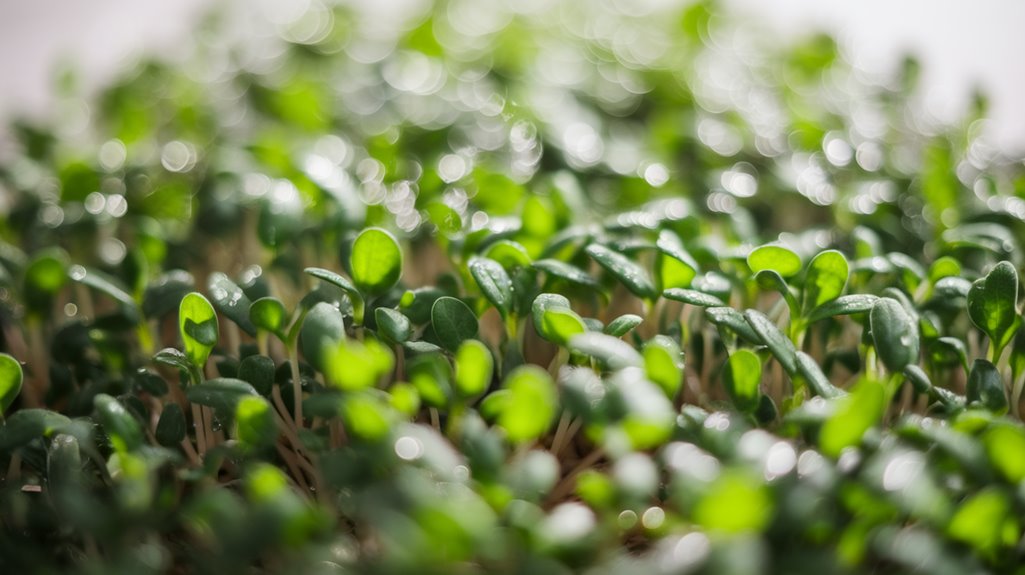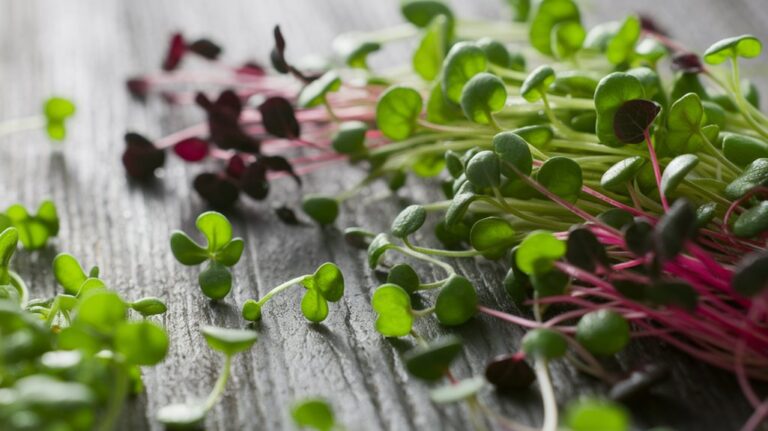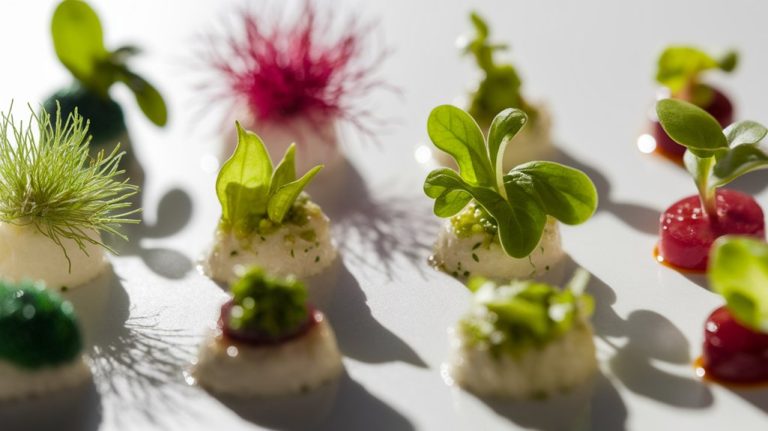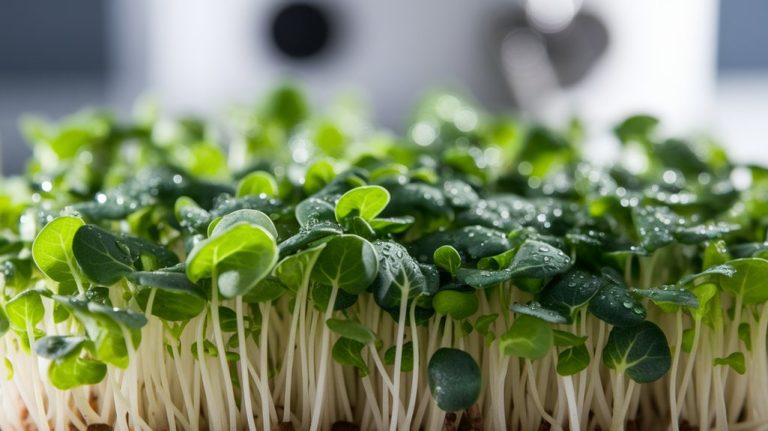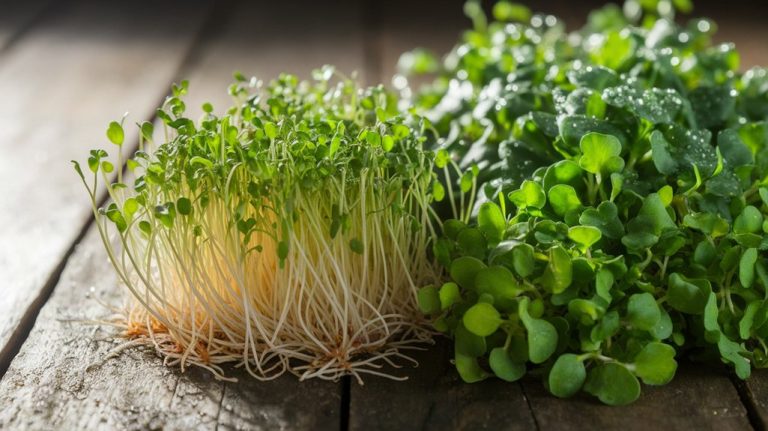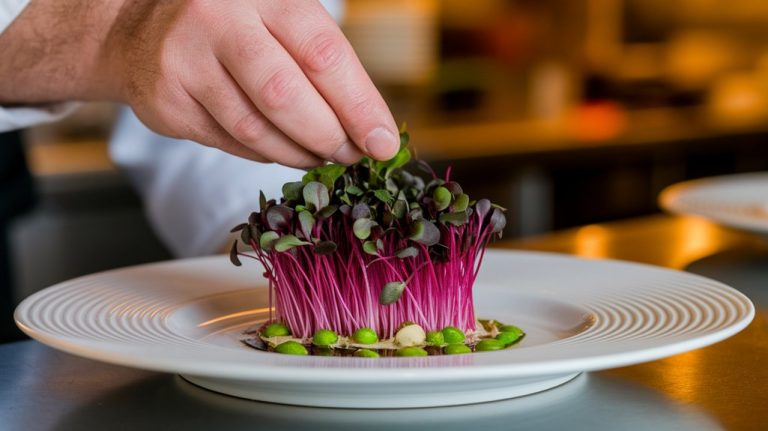The Nutritional Powerhouse: Why Microgreens Should Be Your Superfood
Microgreens are a nutritional powerhouse I can’t recommend enough. These tiny plants pack a serious punch, often containing 4 to 40 times more nutrients than their mature counterparts. They’re rich in vitamins A, C, E, and K, and their vibrant colors indicate beneficial compounds that support overall health. Plus, they’re easy to grow and incorporate into meals, making them a fantastic choice for boosting your diet. Stick around to uncover how to grow and enjoy these superfoods!
Key Takeaways
- Microgreens are nutrient-dense, often containing 4 to 40 times more vitamins and minerals than their mature counterparts.
- High in antioxidants, microgreens support immune function and combat free radicals effectively.
- Rich in essential vitamins A, C, E, and K, they contribute to overall health and well-being.
- Easy to grow at home, they provide a fresh and flavorful addition to meals, enhancing culinary experiences.
- Their low environmental impact, requiring less water and land, makes them a sustainable food choice.
What Are Microgreens?
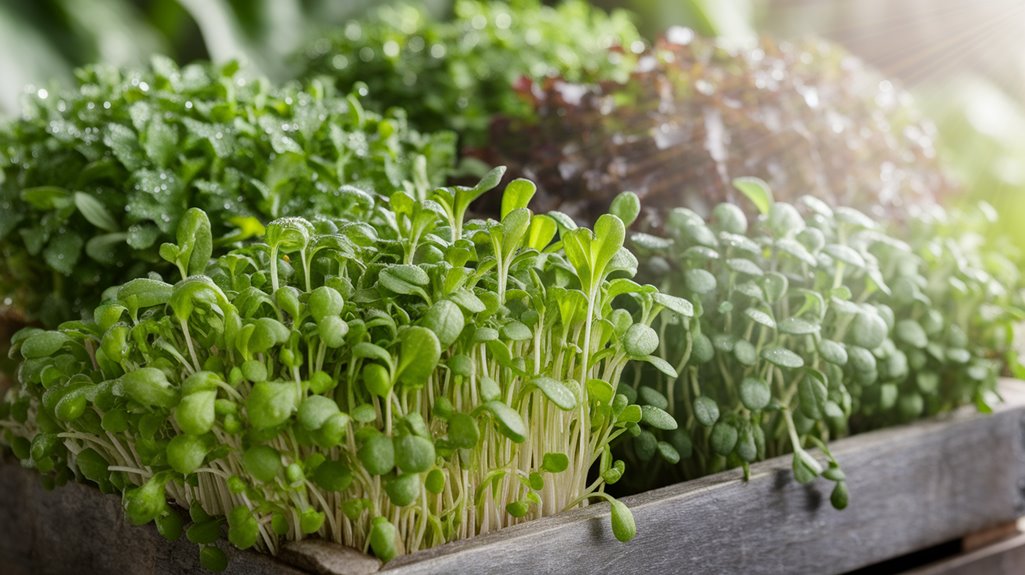
Microgreens are tiny, nutrient-packed plants that pack a powerful punch in terms of flavor and health benefits. These little greens, harvested just after the first true leaves appear, come from a variety of vegetables and herbs.
I love how they’re easy to grow, whether on a windowsill or in a garden. They not only add vibrant color to dishes but also elevate the taste, enhancing everything from salads to sandwiches.
What’s impressive is that microgreens can be 4 to 40 times richer in vital nutrients compared to their mature counterparts. You’re not just adding a garnish; you’re boosting your meals with concentrated flavors and nutrients.
Incorporating microgreens into your diet is a simple yet effective way to enhance your culinary experience while prioritizing health.
Nutritional Benefits of Microgreens
Microgreens are packed with essential vitamins and nutrients that can significantly enhance your health.
I’ve found that their high antioxidant content not only fights free radicals but also supports immune function.
Incorporating these tiny powerhouses into my meals has truly made a positive impact on my well-being.
Rich in Vitamins
While many might overlook the tiny greens sprouting in their kitchens, these vibrant plants pack a powerful nutritional punch. Microgreens are rich in essential vitamins, often containing higher concentrations than their mature counterparts.
For instance, varieties like kale and broccoli boast significant amounts of vitamins A, C, E, and K. I’ve found that incorporating just a handful of these greens into my meals can help meet daily nutrient requirements easily.
Their vibrant colors indicate the presence of beneficial compounds that support overall health. By adding microgreens to salads, sandwiches, or smoothies, you’re not just enhancing flavor but also boosting your vitamin intake.
Trust me, these tiny powerhouses deserve a spot in your diet if you want to elevate your nutritional game!
High Antioxidant Content
Although often overlooked, the high antioxidant content of microgreens is a compelling reason to include them in your diet.
These tiny greens pack a powerful punch, often containing up to 40 times more antioxidants than their mature counterparts. Antioxidants help neutralize free radicals in your body, reducing oxidative stress and lowering the risk of chronic diseases.
By incorporating microgreens like kale, radish, and broccoli into your meals, you’re not just adding flavor and color; you’re significantly boosting your antioxidant intake.
Research shows that a diet rich in antioxidants can improve overall health and longevity.
Boosts Immune Function
One of the standout benefits of incorporating microgreens into my diet is their impressive ability to boost immune function. Research shows that these tiny greens are packed with vitamins, minerals, and antioxidants that fortify our immune system. For instance, nutrients like vitamin C and E, found abundantly in microgreens, play a crucial role in enhancing immune response.
Here’s a quick comparison of some popular microgreens and their immune-boosting properties:
| Microgreen | Key Nutrients | Immune Benefits |
|---|---|---|
| Broccoli | Vitamins A, C, K | Supports skin health |
| Kale | Vitamins C, E | Enhances overall immunity |
| Radish | Vitamin C, Zinc | Promotes white blood cell production |
| Beet Greens | Vitamins A, C, Iron | Aids in oxygen transport |
Incorporating these nutrient-dense microgreens can truly elevate my health!
Popular Types of Microgreens
Microgreens are vibrant little powerhouses that pack a nutritional punch, and I’m excited to share some popular types you might want to incorporate into your meals.
First up, broccoli microgreens are known for their high sulforaphane content, which may help fight cancer and support detoxification.
Then there’s radish microgreens, which have a peppery flavor and are rich in vitamins A, C, and E.
I also love basil microgreens; they add a burst of flavor and antioxidants to dishes.
Don’t overlook sunflower microgreens, either—they’re rich in healthy fats and protein.
Lastly, pea shoots are sweet and nutritious, perfect for salads.
How to Grow Microgreens at Home
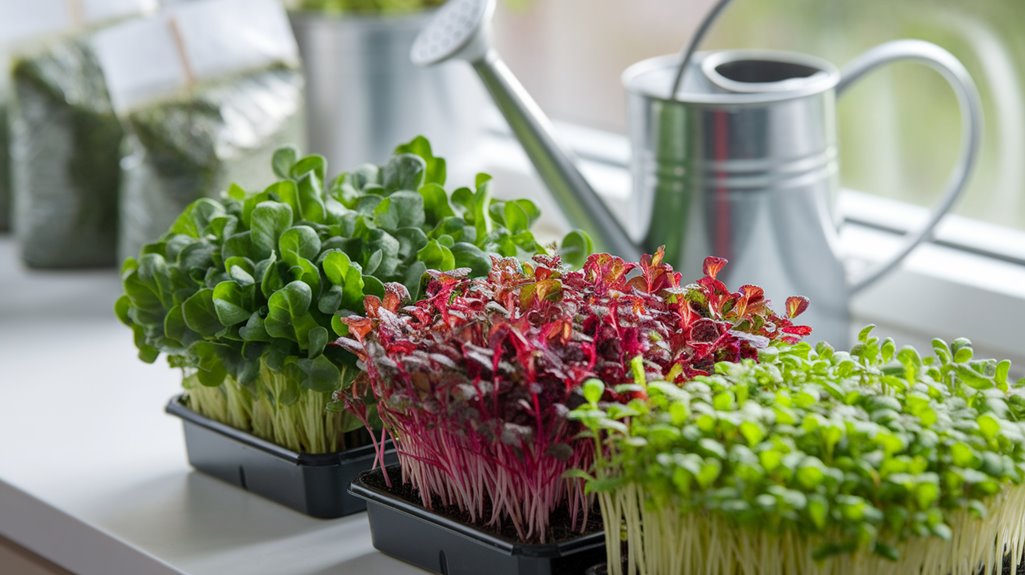
Incorporating microgreens into your meals is simple, but growing them at home is even more rewarding.
To start, gather some seeds—broccoli, radish, or sunflower are great choices. You’ll need a shallow container, potting soil, and a sunny spot.
Fill the container with soil, sprinkle the seeds evenly, and cover them lightly. Water gently, ensuring the soil is moist but not soggy.
Within a week, you’ll see tiny sprouts emerging. Keep them in sunlight, and water daily as needed.
In about 10 to 14 days, your microgreens will be ready to harvest. Just snip them at the base and enjoy the fresh, vibrant flavors.
Trust me, growing your own microgreens is an incredibly fulfilling experience!
Incorporating Microgreens Into Your Meals
Incorporating microgreens into my meals has been a game-changer for both flavor and nutrition.
I love adding them as easy meal additions or using them as vibrant garnishes that elevate any dish.
With their concentrated nutrients and unique tastes, microgreens can transform ordinary meals into something extraordinary.
Easy Meal Additions
While you mightn’t think of them at first, adding microgreens to your meals can significantly enhance both flavor and nutrition.
I’ve found that tossing a handful of radish or arugula microgreens into salads instantly boosts their freshness and crunch. They’re also perfect for adding to sandwiches or wraps, providing a peppery kick that elevates the entire dish.
I love mixing them into omelets or scrambled eggs for a nutrient-packed breakfast. Even smoothies can benefit from a sprinkle of nutrient-dense microgreens—just blend them in for an extra health boost.
These tiny greens are versatile and easy to incorporate, making it a breeze to improve my meals without much effort. Trust me, your taste buds and your body will thank you!
Flavorful Garnishes and Toppings
Microgreens aren’t just great for mixing into meals; they also serve as striking garnishes and toppings that can elevate any dish. When I add microgreens like basil or cilantro to my soups and salads, I instantly notice a burst of flavor and color.
These tiny greens pack a punch, offering concentrated nutrients and antioxidants that enhance both taste and health benefits. Research shows that they can contain up to 40 times more vitamins than their mature counterparts.
Whether topping tacos or finishing a gourmet plate, microgreens create visual appeal and a sophisticated flavor profile. Next time you’re plating a dish, consider these vibrant greens; they’re an easy way to impress while boosting nutrition!
Microgreens vs. Mature Greens: A Comparison

Although many people enjoy the crunch and flavor of mature greens, microgreens offer unique advantages that deserve attention.
I’ve found that microgreens pack a nutritional punch, often containing higher levels of vitamins and antioxidants than their mature counterparts. For instance, studies show that red cabbage microgreens can have up to 40 times more vitamin E than mature cabbage.
Plus, they’re incredibly versatile; I love adding them to salads, sandwiches, and smoothies for an instant health boost.
Another benefit is their rapid growth cycle, allowing for fresher options year-round. While mature greens take longer to grow, microgreens can thrive in small spaces, making them accessible for urban gardeners.
Ultimately, incorporating microgreens into my diet has transformed my meals and health.
The Environmental Impact of Growing Microgreens
When considering sustainable food options, the environmental impact of growing microgreens can’t be overlooked.
I’ve found that these tiny greens require significantly less water and space compared to traditional crops. Their rapid growth cycle means they can be harvested in just a couple of weeks, reducing the carbon footprint associated with longer cultivation times.
Here are a few key points to consider:
- Less Water Use: Microgreens typically consume 90% less water than mature plants.
- Minimal Land Requirement: They can be grown in small indoor spaces, making urban farming more feasible.
- Reduced Transportation Emissions: Growing them locally cuts down on the carbon emissions linked to transporting food.
Embracing microgreens not only benefits our health but also our planet.
Tips for Choosing and Storing Microgreens
After considering the environmental benefits of microgreens, it’s important to know how to select and store these nutritious greens to maximize their freshness and flavor.
When choosing microgreens, I always look for vibrant colors and crisp leaves, avoiding any that appear wilted or discolored. A fresh aroma is also a good sign.
Once I’ve made my selection, I store them in the refrigerator, ideally in a breathable container like a paper towel-lined box. This helps prevent moisture buildup, which can lead to spoilage.
I recommend using them within a week for optimal taste and nutrients. By following these tips, I ensure that I enjoy the full benefits of microgreens in my meals, enhancing both flavor and nutrition.
Frequently Asked Questions
Conclusion
Incorporating microgreens into your diet is an easy and delicious way to boost your nutrition. Packed with vitamins, minerals, and antioxidants, these tiny greens can elevate any meal while offering numerous health benefits. Plus, growing them at home is simple and sustainable. By choosing microgreens over mature greens, you’re not only enhancing your meals but also making a positive impact on the environment. So, why not give microgreens a try? Your body will thank you!

